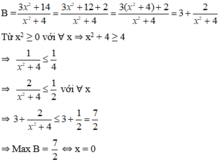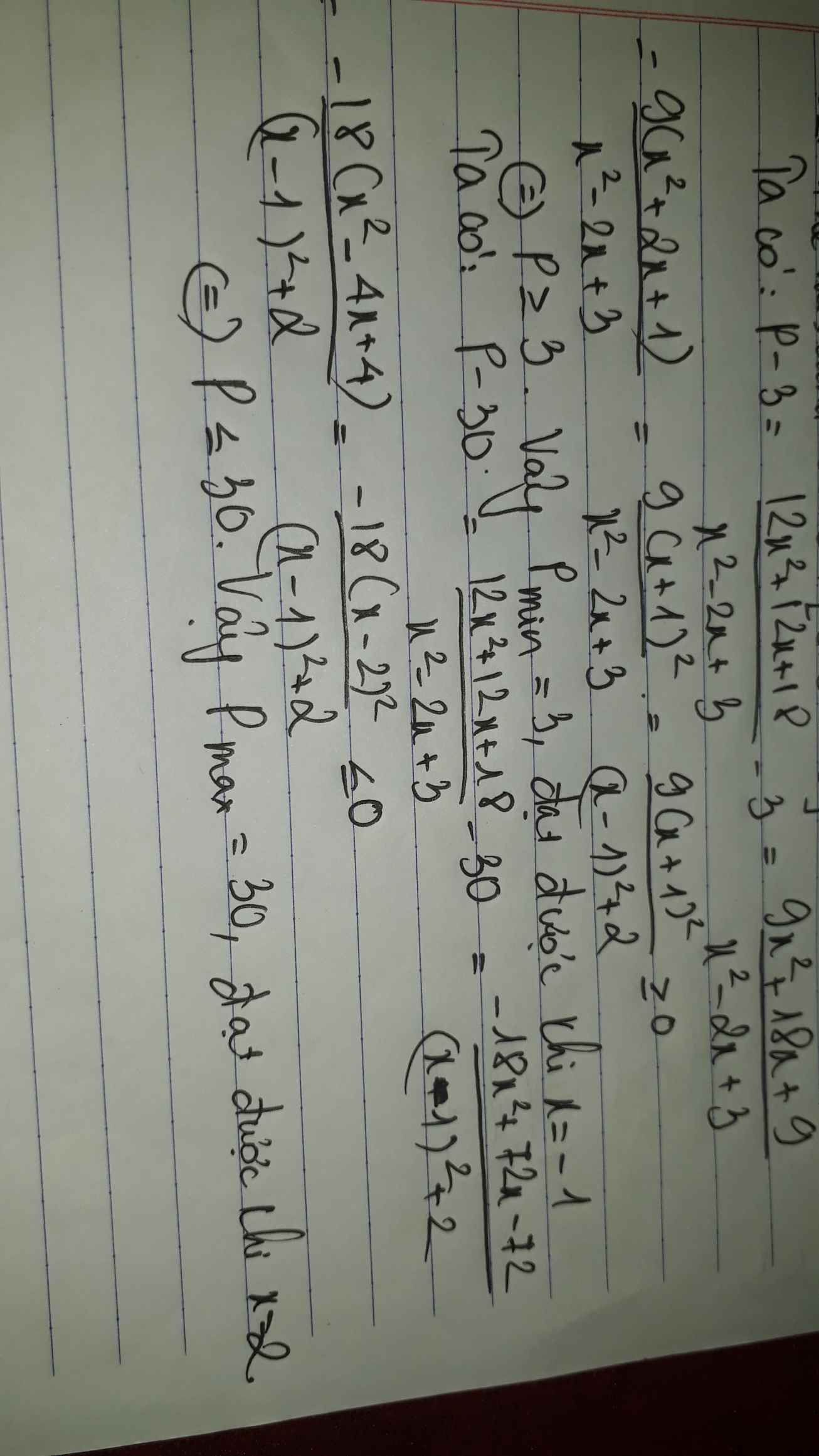Tìm giá trị lớn nhất của biểu thức:
C= -3x2+12x-7
Hãy nhập câu hỏi của bạn vào đây, nếu là tài khoản VIP, bạn sẽ được ưu tiên trả lời.


\(A=x^2-4x+20=x^2-4x+4+16=\left(x-2\right)^2+16\)
Do \(\left(x-2\right)^2\ge0\)
\(\Rightarrow\left(x-2\right)^2+16\ge16\)
\(\Rightarrow Min\left(A\right)=16\)
\(B=x^2-3x+7=x^2-3x+\dfrac{9}{4}-\dfrac{9}{4}+7=\left(x-\dfrac{3}{2}\right)^2+\dfrac{19}{4}\)
Do \(\left(x-\dfrac{3}{2}\right)^2\ge0\)
\(\Rightarrow\left(x-\dfrac{3}{2}\right)^2+\dfrac{19}{4}\ge\dfrac{19}{4}\)
\(\Rightarrow Min\left(B\right)=\dfrac{19}{4}\)
\(C=-x^2-10x+70=-\left(x^2+10x+25\right)+25+70=-\left(x-5\right)^2+95\)
Do \(-\left(x-5\right)^2\le0\)
\(\Rightarrow-\left(x-5\right)^2+95\le95\)
\(\Rightarrow Max\left(C\right)=95\)
\(D=-4x^2+12x+1=-\left(4x^2-12x+9\right)+9+1=-\left(2x-3\right)^2+10\)
Do \(-\left(2x-3\right)^2\le0\)
\(\Rightarrow-\left(2x-3\right)^2+10\le10\)
\(\Rightarrow Max\left(D\right)=10\)

Ta có: Giá trị của biểu thức xác định khi mỗi giá trị của phân thức trong biểu thức đều được xác định.
Khi đó điều kiện xác định là: 2x - 2 ≠ 0; x 2 - 1 ≠ 0 ; 2x + 2 ≠ 0 hay x ≠ ± 1
Vậy với x ≠ ± 1 thì giá trị của biểu thức xác định.


⇒ Giá trị của biểu thức A không phụ thuộc vào biến x

a) \(A=4x^2-12x+100=\left(2x\right)^2-12x+3^2+91=\left(2x-3\right)^2+91\)
Ta có: \(\left(2x-3\right)^2\ge0\forall x\inℤ\)
\(\Rightarrow\left(2x-3\right)^2+91\ge91\)
hay A \(\ge91\)
Dấu "=" xảy ra <=> \(\left(2x-3\right)^2=0\)
<=> 2x-3=0
<=> 2x=3
<=> \(x=\frac{3}{2}\)
Vậy Min A=91 đạt được khi \(x=\frac{3}{2}\)
b) \(B=-x^2-x+1=-\left(x^2+x-1\right)=-\left(x^2+x+\frac{1}{4}-\frac{5}{4}\right)=-\left(x+\frac{1}{2}\right)^2+\frac{5}{4}\)
Ta có: \(-\left(x+\frac{1}{2}\right)^2\le0\forall x\)
\(\Rightarrow-\left(x+\frac{1}{2}\right)^2+\frac{5}{4}\le\frac{5}{4}\) hay B\(\le\frac{5}{4}\)
Dấu "=" \(\Leftrightarrow-\left(x+\frac{1}{2}\right)^2=0\)
\(\Leftrightarrow x+\frac{1}{2}=0\)
\(\Leftrightarrow x=\frac{-1}{2}\)
Vậy Max B=\(\frac{5}{4}\)đạt được khi \(x=\frac{-1}{2}\)
\(C=2x^2+2xy+y^2-2x+2y+2\)
\(C=x^2+2x\left(y-1\right)+\left(y-1\right)^2+x^2+1\)
\(\Leftrightarrow C=\left(x+y-1\right)^2+x^2+1\)
Ta có:
\(\hept{\begin{cases}\left(x+y-1\right)^2\ge0\forall x;y\inℤ\\x^2\ge0\forall x\inℤ\end{cases}}\)
\(\Leftrightarrow\left(x+y-1\right)^2+x^2+1\ge1\)
hay C\(\ge\)1
Dấu "=" xảy ra khi \(\hept{\begin{cases}\left(x+y-1\right)^2=0\\x^2=0\end{cases}\Leftrightarrow\hept{\begin{cases}x+y=1\\x=0\end{cases}\Leftrightarrow}\hept{\begin{cases}y=1\\x=0\end{cases}}}\)
Vậy Min C=1 đạt được khi y=1 và x=0

a)
\(A=4x-x^2+3=-\left(x^2-4x-3\right)=-\left(x^2-4x+4\right)+7=-\left(x-2\right)^2+7\le7\)
Daaus = xayr ra khi: x = 2
b) \(B=4x^2-12x+15=4\left(x^2-3x+9\right)-21=4\left(x-3\right)^2-21\ge-21\)
Dấu = xảy ra khi x = 3
c) \(C=4x^2+2y^2-4xy-4y+1=\left(4x^2-4xy+y^2\right)+\left(y^2-4y+4\right)-3=\left(2x-y\right)^2+\left(y-2\right)^2-3\ge-3\)
Dấu = xảy ra khi
2x = y và y = 2
=> x = 1 và y = 2
a) A = \(-x^2+4x+3=-\left(x-2\right)^2+7\le7\)
Dấu "=" <=> x = 2
b) \(4x^2-12x+15=\left(2x-3\right)^2+6\ge6\)
Dấu "=" xảy ra <=> \(x=\dfrac{3}{2}\)
c) \(4x^2+2y^2-4xy-4y+1\)
= \(\left(4x^2-4xy+y^2\right)+\left(y^2-4y+4\right)-3\)
= \(\left(2x-y\right)^2+\left(y-2\right)^2-3\ge-3\)
Dấu "=" <=> \(\left\{{}\begin{matrix}x=1\\y=2\end{matrix}\right.\)

a) A = x2 + 12x + 39
= ( x2 + 12x + 36 ) + 3
= ( x + 6 )2 + 3 ≥ 3 ∀ x
Đẳng thức xảy ra ⇔ x + 6 = 0 => x = -6
=> MinA = 3 ⇔ x = -6
B = 9x2 - 12x
= 9( x2 - 4/3x + 4/9 ) - 4
= 9( x - 2/3 )2 - 4 ≥ -4 ∀ x
Đẳng thức xảy ra ⇔ x - 2/3 = 0 => x = 2/3
=> MinB = -4 ⇔ x = 2/3
b) C = 4x - x2 + 1
= -( x2 - 4x + 4 ) + 5
= -( x - 2 )2 + 5 ≤ 5 ∀ x
Đẳng thức xảy ra ⇔ x - 2 = 0 => x = 2
=> MaxC = 5 ⇔ x = 2
D = -4x2 + 4x - 3
= -( 4x2 - 4x + 1 ) - 2
= -( 2x - 1 )2 - 2 ≤ -2 ∀ x
Đẳng thức xảy ra ⇔ 2x - 1 = 0 => x = 1/2
=> MaxD = -2 ⇔ x = 1/2
Ta có A = x2 + 12x + 39 = (x2 + 12x + 36) + 3 = (x + 6)2 + 3 \(\ge\)3
Dấu "=" xảy ra <=> x + 6 = 0
=> x = -6
Vậy Min A = 3 <=> x = -6
Ta có B = 9x2 - 12x = [(3x)2 - 12x + 4] - 4 =(3x - 2)2 - 4 \(\ge\)-4
Dấu "=" xảy ra <=> 3x - 2 =0
=> x = 2/3
Vậy Min B = -4 <=> x = 2/3
b) Ta có C = 4x - x2 + 1 = -(x2 - 4x - 1) = -(x2 - 4x + 4) + 5 = -(x - 2)2 + 5 \(\le\)5
Dấu "=" xảy ra <=> x - 2 = 0
=> x = 2
Vậy Max C = 5 <=> x = 2
Ta có D = -4x2 + 4x - 3 = -(4x2 - 4x + 1) - 2 = -(2x - 1)2 - 2 \(\le\)-2
Dấu "=" xảy ra <=> 2x - 1 = 0
=> x = 0,5
Vậy Max D = -2 <=> x = 0,5

a, \(A=-x^2-2x+3=-\left(x^2+2x-3\right)=-\left(x^2+2x+1-4\right)\)
\(=-\left(x+1\right)^2+4\le4\)
Dấu ''='' xảy ra khi x = -1
Vậy GTLN là 4 khi x = -1
b, \(B=-4x^2+4x-3=-\left(4x^2-4x+3\right)=-\left(4x^2-4x+1+2\right)\)
\(=-\left(2x-1\right)^2-2\le-2\)
Dấu ''='' xảy ra khi x = 1/2
Vậy GTLN B là -2 khi x = 1/2
c, \(C=-x^2+6x-15=-\left(x^2-2x+15\right)=-\left(x^2-2x+1+14\right)\)
\(=-\left(x-1\right)^2-14\le-14\)
Vâỵ GTLN C là -14 khi x = 1
Bài 8 :
b, \(B=x^2-6x+11=x^2-6x+9+2=\left(x-3\right)^2+2\ge2\)
Dấu ''='' xảy ra khi x = 3
Vậy GTNN B là 2 khi x = 3
c, \(x^2-x+1=x^2-x+\dfrac{1}{4}+\dfrac{3}{4}=\left(x-\dfrac{1}{2}\right)^2+\dfrac{3}{4}\ge\dfrac{3}{4}\)
Dấu ''='' xảy ra khi x = 1/2
Vậy ...
c, \(x^2-12x+2=x^2-12x+36-34=\left(x-6\right)^2-34\ge-34\)
Dấu ''='' xảy ra khi x = 6
Vậy ...


\(C=-3x^2+12x-7=-3\left(x^2-4x+4\right)+12-7=-3\left(x-2\right)^2+5\le5\)
\(maxC=5\Leftrightarrow x=2\)
\(C=-3\left(x^2+4x+4\right)+5=-3\left(x+2\right)^2+5\le5\)
Dấu \("="\Leftrightarrow x=-2\)